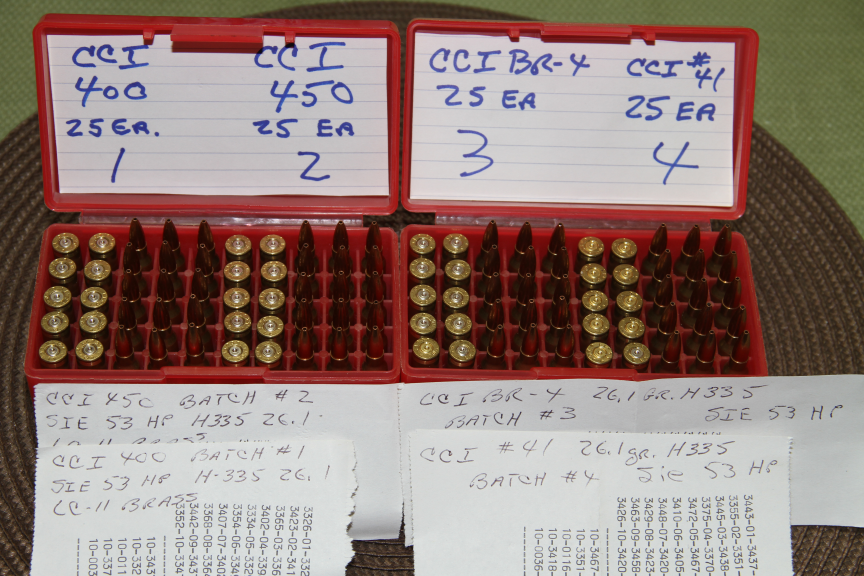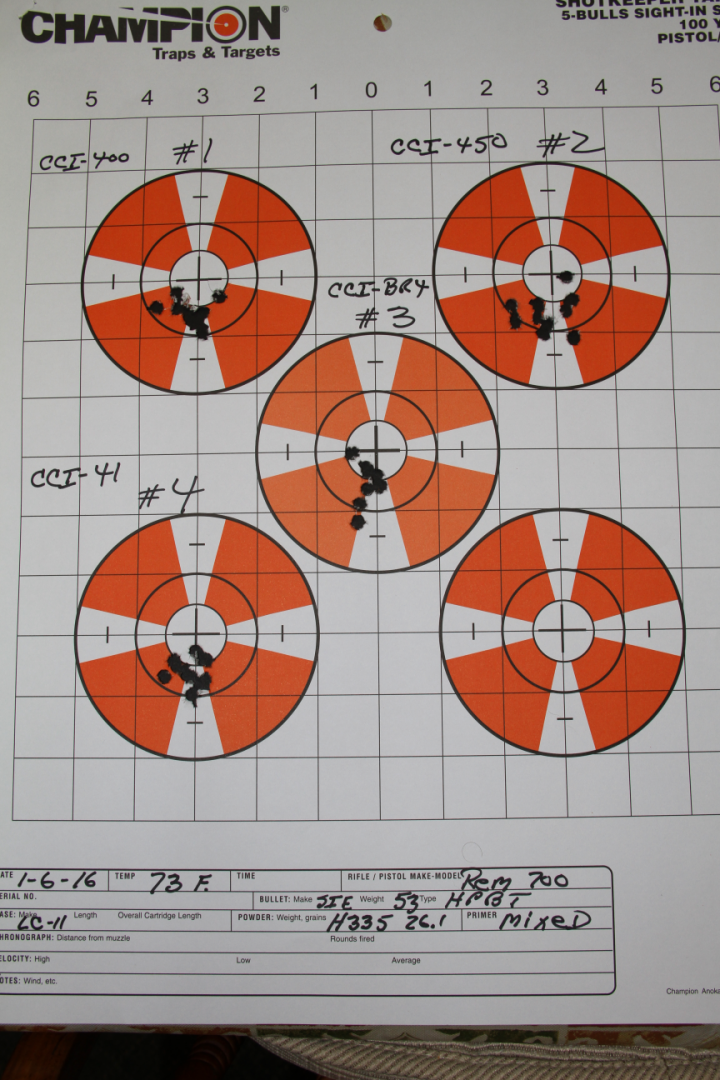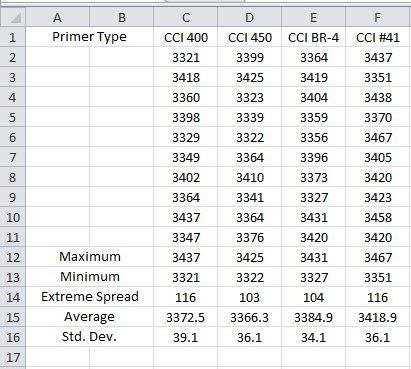
 |
|
|||||||
| Forum Rules | Firearms Safety | Firearms Photos | Links | Library | Lost Password | Email Changes |
| Register | FAQ | Calendar | Today's Posts | Search |
 |
|
|
Thread Tools | Search this Thread |
|
|
#1 |
|
Senior Member
Join Date: October 25, 2001
Location: Alabama
Posts: 19,189
|
Primer Effect - Small Pistol Divison.
We see frequent angst over primer selection:
"The "recipe" calls for Acme primers but all I have is Brand X, what do I do?" "I accidentally bought magnum primers instead of standard, what do I do?" The usual response is: "Reduce your load by 10% and "work up."" So I thought I would check it out, as applies to bulk pistol ammo. My current IDPA ESP 9mm load is a 135 gr BBI Hi-Tek coated RN and 3.8 gr HP38. For this test I sorted out all Winchester brass and weighed all powder. Shot over a ProChrono Digital 12 ft away with a Springfield 1911A1 9mm, factory 5" barrel. Average of five rounds. Winchester Small Pistol Standard - 1019 fps CCI Small Pistol Standard ---------- 1020 fps Federal Small Pistol Standard ------ 1021 fps Remington Small Pistol Standard -- 1044 fps CCI Small Pistol Magnum ----------- 1022 fps Federal Small Rifle Standard ------- 1023 fps Winchester Small Rifle Standard --- 1026 fps CCI BR4 Small Rifle Match ---------- 1019 fps Now isn't that interesting. Seven out of eight primers, rifle and magnum included, within 7 fps. And the oddball noticeably faster, is the plain Rem 1 1/2 small pistol standard, not one of the accepted "hotter" rifle or magnum. And then only by 23 fps from the average of the other 7; about 2%. Of course you might get different results in different calibers or with different powders. But a large pistol magnum gave a whopping 11 fps gain over standard in .45 ACP loaded with Bullseye. |
|
|
|
|
#2 |
|
Senior Member
Join Date: March 10, 2016
Posts: 598
|
I've heard to reduce load by 3 percent when changing primers. Looks like this agrees with that
|
|
|
|
|
#3 |
|
Senior Member
Join Date: October 25, 2001
Location: Alabama
Posts: 19,189
|
Well, only when going to Remington in this case.
I also shot some with 3.6 gr powder and the magnum and rifle primers. Velocity fell off by an average of 3% for a powder reduction of 5.5% |
|
|
|
|
#4 |
|
Senior Member
Join Date: March 23, 2012
Location: Conway, Arkansas
Posts: 1,398
|
Jim, I didn't realize you were on here as well as TRR. Lol.
Great work sir! Sent from my iPhone using Tapatalk |
|
|
|
|
#5 |
|
Staff
Join Date: March 4, 2005
Location: Ohio
Posts: 21,743
|
I'm only seeing 2.4% velocity change, but yes, if the powder is running in a flatter part of its pressure vs. burn rate curve, you can have to change it by a bigger percent than the velocity change.
Rocky Raab had an old rule of thumb that if you change only one component (primer, case, powder lot number, bullet of same weight) in a load, 5% is the reduction to make. Today, if the bullet is the thing being changed, there are more variables, such as solids vs. jacketed vs. lead and long VLD vs. stubbier design and the like. But usually it works out for the bullet as well, if it is the same weight.
__________________
Gunsite Orange Hat Family Member CMP Certified GSM Master Instructor NRA Certified Rifle Instructor NRA Benefactor Member and Golden Eagle |
|
|
|
|
#6 |
|
Senior Member
Join Date: March 10, 2016
Posts: 598
|
I'd also be interested in the standard deviation difference in the primers
|
|
|
|
|
#7 |
|
Senior Member
Join Date: June 8, 2016
Location: Cleveland, Ohio Suburbs
Posts: 1,756
|
I did a similar little science experiment this past summer but using .223 Remington from a bolt action rifle. I used only CCI brand primers of four types. The load data went as follows:
Cartridge: .223 Remington Cases: LC 11 Brass Powder: H 335 Charge Weight: 26.1 grains Bullet: Sierra 53 grain HP Match Note: All cases were trimmed to a uniform 1.750" and loaded to a C.O.A.L. of 2.250". All powder charges were weighed. I fired 10 shot groups over the chronograph. The groups likely could have done much better but I was more focused on shooting accurately through my sky screens than focused on the targets 100 yards down range. The four primers I used were CCI 400 Small Rifle, CCI 450 Small Rifle Magnum, CCI BR-4 Small Rifle Bench Rest and CCI #41 for 5.56 ammunition. The CCI 450 and CCI #41 are both classified as a small rifle magnum type primer. So we have two magnum and two standard primers. The boxes of my loaded ammunition:  The target labeled for each group of ammunition, these were ten shot groups at 100 yards:  The results in spread sheet form:  Draw your own conclusions but interesting in that the magnum primers did not always give the higher velocities for a given load. Next summer I would like to run a similar experement in .308 Winchester (7.62 x 51). Ron Last edited by Reloadron; November 19, 2016 at 03:42 PM. |
|
|
|
|
#8 |
|
Senior Member
Join Date: October 25, 2001
Location: Alabama
Posts: 19,189
|
I don't know how much SD tells you on five shot strings but...
In the base load of 3.8 gr HP38 WLP had the lowest SD 5, the "fast" Remingtons were the least consistent at SD 16. Others were all over the map in between. The VERY lowest SD was with the 3.6 gr load, not in the table; FSR at SD 3. A PhD who got interested in reloading analyzed a lot of .38 Special data, and concluded that a coefficient of variation, (SD as a percentage of the average) of 1% was "match grade" and up to 2% was not bad. So SD 16 vs average 1044 is CV 1.5%, perfectly usable. On the other hand, black powder when loaded right is very uniform. Velocity SD had better be in the single digits, CV well under 1%, and a good load will have EV in the single digits. Reloadatron: I understand that CCI BR and #41 military primers are of "magnum force." Last edited by Jim Watson; November 19, 2016 at 12:49 PM. |
|
|
|
|
#9 |
|
Senior Member
Join Date: September 28, 2013
Posts: 5,183
|
My observation is that primers make more noticeable difference in lighter loads with slower powders. My own rule of thumb is 5% charge reduction or the minimum published load.
-TL |
|
|
|
|
#10 |
|
Senior Member
Join Date: October 25, 2001
Location: Alabama
Posts: 19,189
|
I do not care to make up light loads with slow burning powder so that shift does not affect me.
I dropped HS6 because anything less than a top load was inconsistent and nasty. I don't have the "Clean Powder" hangup, but sub-maximum HS6 was the only powder that has ever coked up my 9mm to the point of malfunction in a single practice or match. |
|
|
|
|
#11 |
|
Senior Member
Join Date: September 28, 2013
Posts: 5,183
|
Understood.
Your results are good. But it would be imprudent for a reader to conclude that primers have no effects on pressure and velocity. They do, depending on the circumstances, the effects may or may not be noticeable. I like slower powders myself for different reasons. That's how I noticed the primers effects. -TL |
|
|
|
|
#12 |
|
Senior Member
Join Date: October 25, 2001
Location: Alabama
Posts: 19,189
|
To quote a usually reliable source (Me!) when we are considering what "applies to bulk pistol ammo" there are a lot of things that can be done that you would not do for maximum loads, hot rifle loads, or National Match pistol ammo.
|
|
|
|
|
#13 |
|
Staff
Join Date: March 4, 2005
Location: Ohio
Posts: 21,743
|
Tangolima,
All else being equal (and realizing that it seldom is) slower powders, having heavier deterrent coatings, are harder to ignite than fast ones are. For that reason, you'll pick up on primer differences more readily with a slow powder than with a fast one. Reloadron, Jim is correct. You have 3 magnum primers and one standard one (the 400). Interestingly, your best group comes from the #41 military sensitivity spec primer, which is the hardest of the bunch to ignite. You shouldn't get an average error if you let the spreadsheet do the figuring. Perhaps you did and it's a cut and paste error, but these functions are so commonly used by shooters that I'll put the Excel and Open Office formulas below for people new to it: Code:
C12 =MAX(C2:C11) Finds the maximum value for the range of values in C2 through C11
C13 =MIN(C2:C11) Finds the minimum value for the range of values in C2 through C11
C14 =C12-C13 Finds the extreme spread based on the above two
(Alternative C14 for when you don't figure min and max separately: =MAX(C2:C11)-MIN(C2:C11)
C15 =Average(C2:C11) Finds the average value for the range of values in C2 through C11
C16 =STDEV(C2:C11) Finds the sample standard deviation for the range of values in C2 though C11
__________________
Gunsite Orange Hat Family Member CMP Certified GSM Master Instructor NRA Certified Rifle Instructor NRA Benefactor Member and Golden Eagle |
|
|
|
|
#14 |
|
Senior Member
Join Date: June 8, 2016
Location: Cleveland, Ohio Suburbs
Posts: 1,756
|
Unclenick, again don't overly look at the group sizes as I really was more focused on shooting through my skyscreens but yes, the best group was with the #41 primers.
Enter a question. The CCI 400 is a standard small rifle primer, The CCI 450 and CCI #41 are classified as Magnum small rifle. So if I have that correct then we are saying the CCI BR-4 (CCI Bench Rest 4) is classified as a Magnum prmer? My understanding is was a standard primer. Thanks Ron |
|
|
|
|
#15 |
|
Senior Member
Join Date: October 25, 2001
Location: Alabama
Posts: 19,189
|
It's sure SHOOTING like a magnum primer... this time.
|
|
|
|
|
#16 | ||
|
Senior Member
Join Date: June 8, 2016
Location: Cleveland, Ohio Suburbs
Posts: 1,756
|
Jim,
Quote:
Quote:
 That's a fact! That's a fact!  Thanks for pointing that out. Ron |
||
|
|
|
|
#17 |
|
Senior Member
Join Date: June 30, 2009
Location: dallas
Posts: 779
|
Lots of good science here. Personally, I'm going to pray we never have another primer shortage so we can buy what ever primer we want. Same for powder.
|
|
|
|
|
#18 |
|
Senior Member
Join Date: October 25, 2001
Location: Alabama
Posts: 19,189
|
Yes, I hope the pipeline opens up and I get my Panic Backorder primers in.
|
|
|
|
|
#19 |
|
Senior Member
Join Date: June 8, 2016
Location: Cleveland, Ohio Suburbs
Posts: 1,756
|
Hopefully our supplies of primers and other reloading components will be secure and plentiful for at least the next 4 years. However, as past experiences have proved, it is indeed a fragile supply and it doesn't take much to disturb the supply. Fortunately primers and powder do have a long shelf life.
Ron |
|
|
|
|
#20 |
|
Senior Member
Join Date: September 28, 2008
Posts: 10,442
|
Thanks for the data.
During recent and not so recent component shortages, what ever primers could be found had to do, including using magnums instead of standard. Beggars can't be choosers. Judging from my own results, there wasn't enough difference to matter. Powder drop variances were greater than what primers caused. Glad to know it was really ok, and it would be safe to do should the shelves get empty again. So, thanks. |
|
|
|
|
#21 |
|
Staff
Join Date: March 4, 2005
Location: Ohio
Posts: 21,743
|
I find that true for practical purposes with large rifle primers in medium power cases like .308 to .30-06, but the small ones seem to make some real difference.
Reloadron, I'm going by the testing I've done and seen, the BR-4's have been warm and produced as much as 5% higher velocity than a Federal 205 with the same load (55 grain V-max over 24 grains Reloader 10X in a .223). In Jim's 9 mm it didn't produce high velocity, but magnum primers sometimes produce low velocities in tight spaces by helping unseat the bullet, so I can't say from that. In your test is looks like H335 didn't find it particularly warm, but that's a hard-to-ignite older spherical powder, so the energy may be going elsewhere in that instance. It could also be the in the tests I've seen and done we had hotter batches than are average. These were early days for the BR-4, IIRC. If I remember to, I'll call CCI and ask tomorrow.
__________________
Gunsite Orange Hat Family Member CMP Certified GSM Master Instructor NRA Certified Rifle Instructor NRA Benefactor Member and Golden Eagle |
|
|
|
|
#22 |
|
Senior Member
Join Date: June 8, 2016
Location: Cleveland, Ohio Suburbs
Posts: 1,756
|
Hi Ya Unclenick, I did shoot them an email but a phone call is always quicker. Every time I have had a primer related question they have been right there with the answers. My emails on weekends generally take 3 to 5 days depending on how busy they are. I am curious as to how CCI looks at their BR line of primers. If you give them a call please share what they tell you.
Looking out there today I do not see me doing more test in .308 Winchester or anything till spring.  I would like to follow up with more data and primer results. NE Ohio sucks today and I believe you are in Central Ohio which I doubt is any more pleasant. :0 I would like to follow up with more data and primer results. NE Ohio sucks today and I believe you are in Central Ohio which I doubt is any more pleasant. :0I thought about what you mentioned where a hot primer gets the bullet out before the powder really gets going. I have wondered about that before. Ron |
|
|
|
|
#23 | |
|
Senior Member
Join Date: June 8, 2016
Location: Cleveland, Ohio Suburbs
Posts: 1,756
|
Just for clarification I posed the following question to CCI:
"Would the CCI BR-4 Primer be classified as a Standard or Magnum small rifle primer? Likewise the CCI #41 primer, would it be Standard or Magnum classified? Thank You" Here is the reply: Quote:
Ron |
|
|
|
|
|
#24 |
|
Senior Member
Join Date: February 4, 2008
Posts: 200
|
Very interesting....
Negligible difference between most all but the Rems. Wouldn't matter much with a wide operating range powder like the HS-6 I use, unless operating at max range, which I don't. Some other powders would be an issue with that much of a difference I'd think....and of course potentially hazardous to your health if max. loads aren't first reduced. Last edited by sixgunluv; November 24, 2016 at 03:36 PM. |
|
|
|
|
#25 |
|
Senior Member
Join Date: February 7, 2009
Location: Southern Oregon!
Posts: 2,891
|
I too see many, many of the new reloader's posts "I only have Whammo primers, can I use them in my Doofus magnum?", or something like that. So, perhaps make this thread a stickie?

|
|
|
 |
|
|